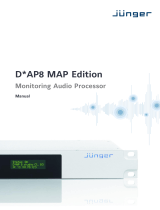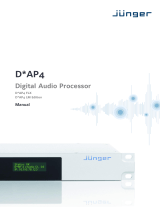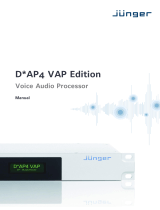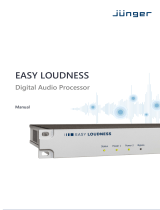
Netbridge_manual_EN_180302
digital audio
format
bridging system
Dual 64ch MADI & AoIP bridging system
Netbridge MADI
Netbridge MADI is an advanced interface for simple and fast bridging between Audio-
over-IP (AES67 & Dante™) and MADI infrastructures.
With its two independent MADI and AoIP interfaces it handles up to 128 audio channels.
Features
• Dual Interface for AoIP (AES67 or DanteTM)
• Four AoIP network ports for redundant or switch operation
• Dual MADI I/O connection
• Dual AES3id MADI receiver and transmitter
• Word length 24bit
• Extended mode (64ch)
• High sampling mode (32 channels @ 96kHz)
• 128 channel bridging between MADI and AoIP network

digital audio
format
bridging system Netbridge MADI
Dual 64ch MADI & AoIP bridging system
2/4
Technical Specifications – MADI interface
Standards Relevant specifications comply with AES10-2008 and AES11-2009.
Audio 24bits, transparent forwarding of PCM
Audio Sample Rates 44.1, 48kHz
BNC Input 64/56 channels @ 44.1 and 48kHz
Impedance 75Ohm
Input level 0.15 … 0.8Vpp @ 75Ohm
Cable length (max.) 150m (Belden 1694A)
BNC Output 64/56 channels @ 44.1 and 48kHz
Impedance 75Ohm
Output voltage 0.6Vpp (typ.) @ 75Ohm
General Features • Input cable equalizer for extended range and robustness
• Reference grade word clock recovery, master-sync capable
• Dedicated routing for non-processed channels, all channels
(max. 64) can be routed to/from the device or looped through
• AES3 channel status management, non-audio detection
Technical Specifications – AoIP (AES67 / DanteTM) interface
Standards Audio-over-IP by Audinate Dante™ Digital Audio Networking Standard
AES67 compliant
Audio 24bits, transparent forwarding of PCM and compressed audio
Audio Sample Rates 44.1, 48kHz
Inputs and Outputs 2 x Gigabit Ethernet RJ45 connectors (100M/1Gbit),
primary and secondary port
Inputs 64 channels @ 44.1, 48kHz
Outputs 64 channels @ 44.1, 48kHz
General Features • AES67 compliant
• Network master-sync can be provided by c8k frame
• Master-sync capable
• Non-audio detection for input channels
• Glitch-free Dante™ audio redundancy using dual Ethernet
networks

digital audio
format
bridging system Netbridge MADI
Dual 64ch MADI & AoIP bridging system
3/4
Jünger Audios Netbridge MADI is very easy to set up and does not require complex
configuration. All system related parameters are accessed from Audinates DanteTM
Controller software. Please download Audinates DanteTM Controller from:
https://audinate.com/products/software/dante-controller
Install and run the software to configure your DanteTM network.
Basic Principle
Netbridge MADI facilitates two independent bridges between the DanteTM network and a
MADI interface. Both bridges can be used independently (with different sources and
networks) or together in one DanteTM network. Just connect them to the same or
independent switches or even single DanteTM clients. Each of the 128 converters can be
addressed independently by just using the matrix to select a source and a sink/destination
from the network:

digital audio
format
bridging system Netbridge MADI
Dual 64ch MADI & AoIP bridging system
4/4
Selecting a sync source
ATTENTION: Currently sync source selection needs to be made manually by DIP
switches inside the device. Please get in touch with the Jünger Audio support team to
get further instructions. Default sync source is DanteTM Network. The following
paragraph is for future reference only!
By default Netbridge MADI is synced from the DanteTM network. In this case use the MADI
output to sync the connected MADI system as clock slave device. However sometimes it
makes sense to use the MADI input as a sync source and slave the DanteTM network to this
port. Netbridge MADI automatically switches sync to MADI input, whenever the DanteTM
network is allowed to sync from external. This configuration can be found in the DanteTM
Controller under the ‘Clock Status’ tab:
/








